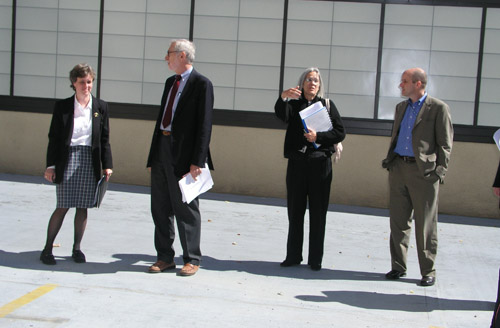
Uh oh! The mayor of DC wants your cubicle!
D.C. would like all that excess federal office space given up.
If you don’t want your office back, the District of Columbia would like to turn it into a nice condominium or apartment.
That’s the gist of what freshly reelected Mayor Muriel Bowser said the other day. She wants more people to live in “downtown” Washington, or establish businesses there. And she specifically called on the White House to either get agencies to fully re-occupy their “vast property holdings” in the city, or give it up.
I’m presuming Bowser meant leased space. The General Services Administration’s Federal Buildings Service lists 55 government buildings in D.C., but it’s hard to tell from the list which ones are leased. The Jackson Place White House Service Center isn’t likely to go condo, say, nor the National Archives (great lobby, though). But the big, fancy “Constitution Center” building at 7th and D Streets Southwest is privately owned and leased to the government. It houses people from a half dozen agencies and encompasses 1.4 million square feet and lots of parking.
A Government Accountability Office report from last September showed that the GSA has in fact steadily trimmed both the number of leases it manages and the square footage — a process that’s been happening since around 2014. That reduction accelerated after the pandemic cleared out many offices. Now GSA manages fewer than 8,000 leases, down from a high of around 9,600. It has 175 million square feet under lease, down from nearly 200 million.
Beyond that, it’s impossible to really know how intensively the government uses a given leased office. Do 80% of the staff telework 40% of the time? All that’s really out there are vague surveys and guesstimates as to precisely how much space the government will permanently need in a given location. It’s never static, but what will the average be?
In 2023, every organization is going to have to decide once and for all what its work location policies are going to be, and adjust its real estate to fit. With a fussy labor market, still-frequent cases of various viruses, and lots of people preferring telework, that’s not going to be easy for management.
Published reports I’ve read, though, say that the upper hand seems to be sliding back to management. One story, in the Wall Street Journal yesterday, quoted the chief executive of Goldman Sachs: “We have nudged, cajoled, evolved. But the bottom line is, we generally are operating pretty close to the way we operated before the pandemic.”
One of the local D.C. newspapers back in March published an editorial, urging the re-population of federal offices, mainly as a way of helping the District and the D.C. region’s mass transit Metro system economically. The Washington Post quoted President Joe Biden: “It’s time for America to get back to work and fill our great downtowns again. We’re doing that here in the federal government. The vast majority of federal workers will once again work in person.”
Well not quite. Most employees come to the office sometimes. Which means most employees telework sometimes. Eventually the government will have to face the question of how much space it really needs. And of how it manages the space it does have. That is, if in a workforce of 1,000, 500 are in their offices on a given day, do agencies continue to pay rent on 1,000 seats, or do they switch to the drop-in “hotel” model and permanently give up space?
Madame Mayor is waiting.
Copyright © 2024 Federal News Network. All rights reserved. This website is not intended for users located within the European Economic Area.
Tom Temin is host of the Federal Drive and has been providing insight on federal technology and management issues for more than 30 years.
Follow @tteminWFED






